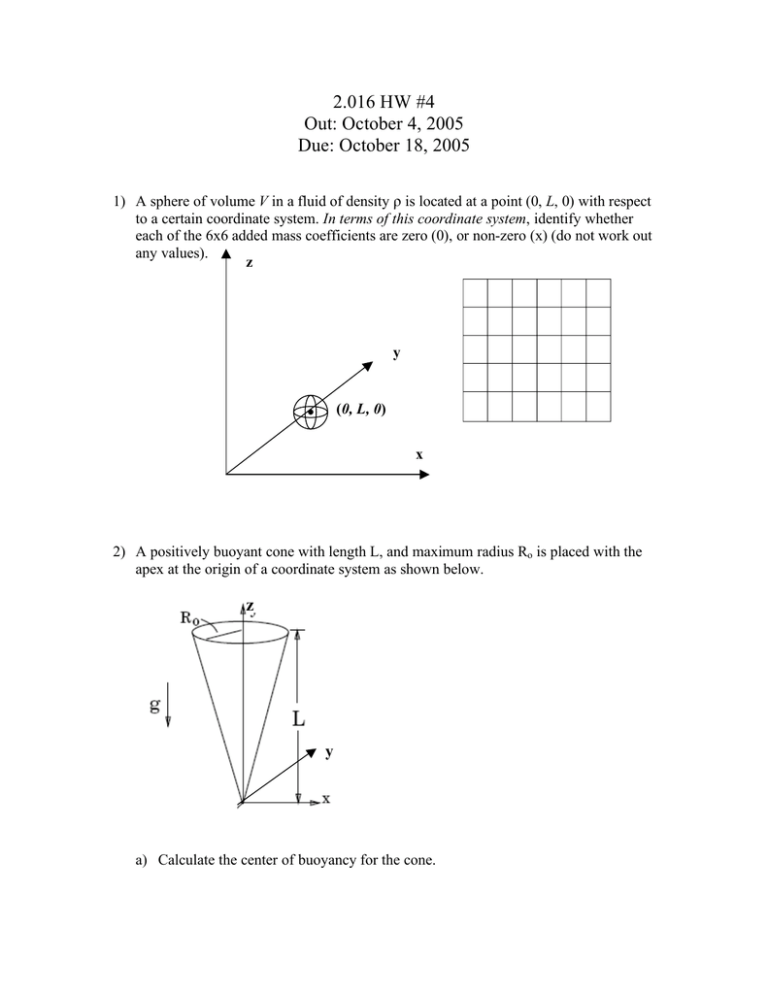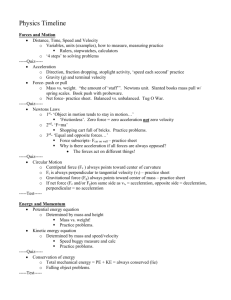2.016 HW #4 Out: October 4, 2005 Due: October 18, 2005
advertisement

2.016 HW #4 Out: October 4, 2005 Due: October 18, 2005 1) A sphere of volume V in a fluid of density ρ is located at a point (0, L, 0) with respect to a certain coordinate system. In terms of this coordinate system, identify whether each of the 6x6 added mass coefficients are zero (0), or non-zero (x) (do not work out any values). z y (0, L, 0) x 2) A positively buoyant cone with length L, and maximum radius Ro is placed with the apex at the origin of a coordinate system as shown below. z y a) Calculate the center of buoyancy for the cone. b) Determine which added mass coefficients are zero or non-zero. You can fill out a 6x6 matrix with X for non-zero and 0 for zero. c) Use Strip Theory to calculate M55, M11, M44, M66, M51, and M22. Hint: first consider any symmetry that might make these calculations easier. d) Write the equation of motion of the cone in roll, and calculate the natural frequency. 3) A new class of submarine can be modeled by a cylinder of length L and radius R, with a vertical sail and horizontal elliptical wings of major and minor axis radii a and b and length h, as shown. Assuming that these main members are slender so that their longitudinal added mass may be ignored, and neglecting also the interactions among the members, determine a) M33 b) M35 c) M55 v v d) Find the instantaneous force and moment, F and M , on the submarine at an instant when its 6 degree-of-freedom motions are: velocity [1,2,3,1,2,3] and acceleration [3,2,1,3,2,1]. You may leave your answers in terms of Mij. 4) Housing for certain underwater sensor equipment has a geometry shown below. The sphere has radius 2a, and the cylinders have radius rc = a/2 and length lc=4a. The density of the device can be assumed to be uniform and have a value of twice that of water. (ASSUME NON-VISCOUS FLOW ONLY!) a) To get it to the sea floor, the device is lowered into the water and then is released, find its initial acceleration for (i) a vertical orientation; and (ii) a horizontal orientation. b) Assuming deep water, calculate the terminal drop velocity for the device falling in a horizontal orientation for (i) very small a; and (ii) large a. c) If the instrument is dropped horizontally with initial generalized velocity (0, -U2, U3, 0, 0, 0). Find the moments (M1, M2, M3) on the cylinder at the instant the cylinder is dropped in terms of a, ρ, U2, U3. d) An engineer is concerned that if dropped in a vertical orientation, the device may become “unstable” and reach the bottom in an unpredictable manner. If the equipment is falling with steady downward velocity U, at a small angle θ from its vertical position, estimate, based on potential (non-viscous) flow effects only, the overturning moment M2 on the device as a function of U and θ5. 5) 2D Deep Water Waves can be described by a velocity potential function φ(x, z,t). a! kz e sin(kx # !t ) k The relationship between frequency, ω, and wave number, k, is given by the dispersion relationship for deep water waves: " ( x, z , t ) = # ! 2 = gk Assuming deep water wave of amplitude a = 2.5ft, wavelength λ = 120ft ( ! = 2" / k ) and frequency, ω, dictated by the dispersion relation. Use the expressions for a linear wave, derived in class, to plot: a. Plot the dynamic pressure, the horizontal velocity and acceleration, the vertical velocity and acceleration as a function of the variable x, for a fixed value of the time t, all quantities can be evaluated at z = zn, where zn = λ/8. You can calculate the velocities and accelerations based on the relationship between potential function and velocity for fundamental potential flow theory. Align all plots so that the relative phase can be deduced, and plot the wave elevation, also as a function of x, for comparison. b. Plot the same quantities as in the first question as a function of time t (at a fixed value of x and for z = zn). c. The inviscid force is proportional to the fluid acceleration. When is the horizontal inviscid force maximum: under the wave crest, the wave trough, or the wave nodal point? Answer the same question for the vertical inviscid force. d. The viscous force is proportional to the fluid velocity squared. When is the horizontal viscous force maximum: under the wave crest, the wave trough, or the wave nodal point? Answer the same question for the vertical viscous force. e. Calculate the TOTAL pressure under a plane progressive wave at some depth H1 that you should find under the wave crest, the wave trough, and the wave nodal point. Explain from where you measure the vertical distance z used in the hydrostatic pressure.



